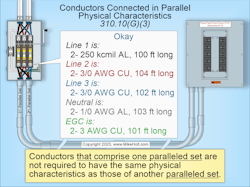Courtesy of www.MikeHolt.com
All questions and answers are based on the 2020 NEC.
Q. What are the rules related to paralleling of conductors?
A. The requirement associated with the paralleling of conductors can be found in Sec. 310.10 [Uses Permitted].
(G) Conductors Connected in Parallel.
(1) 1/0 AWG and Larger. Phase, neutral, and equipment grounding conductors are permitted to be connected in parallel (electrically joined at both ends). When paralleling phase and neutral conductors, they must be sized 1/0 AWG and larger.
Author’s Comment: When conductors are installed in parallel (electrically joined at both ends), the current flow will be evenly distributed between the individual parallel conductors.
(2) Conductor and Installation Characteristics. All parallel phase conductors, neutral conductors, equipment grounding conductors, and supply-side bonding jumpers must comply with the following:
(1) Be the same length.
(2) Be the same conductor material (copper, aluminum, or copper-clad aluminum).
(3) Be the same size in circular mil area (minimum 1/0 AWG).
(4) Have the same type of insulation.
(5) Terminate in the same manner (set screw versus compression fitting).
Author’s Comment: Raceways or cables containing parallel conductors for Phase A, Phase B, Phase C, neutral, and the equipment grounding conductor must have the phase, neutral, and equipment grounding conductors (or supply-side bonding jumpers) in each raceway [Sec. 300.3(B)(1)]. Conductors that comprise one paralleled set are not required to have the same physical characteristics as another paralleled set (see Figure).
(5) Equipment Grounding Conductors. Equipment grounding conductors must be sized per Sec. 250.122(F), but they are not required to be 1/0 AWG and larger.
(6) Bonding Jumpers. Supply-side bonding jumpers must be sized per Sec. 250.102(C) and load-side bonding jumpers must be sized per Sec. 250.102(D), but they are not required to be 1/0 AWG and larger.
Q. What are the NEC requirements related to cabinets, cutout boxes, and meter socket enclosures in wet locations?
A. Section 312.2.
Weatherproof. Cabinets for panelboards, cutout boxes for disconnects, and meter cans installed in damp or wet locations must be weatherproof.
According to Art. 100, “Weatherproof” means constructed or protected so exposure to the weather will not interfere with successful operation [Art. 100].
Above Live Parts. Raceways entering above the level of live parts (such as busbars and overcurrent devices) of cabinets, cutout boxes, and meter cans in wet locations must use a sealing locknut, Myers hub, or connector listed for wet locations.
Author's comment: In accordance with “UL Guide Information DWTT,” sealing locknuts are permitted on the outside or inside of the enclosure for RMC, IMC, or inside the enclosure for connectors if marked for this use on the fitting carton.
These materials are provided to us by Mike Holt Enterprises in Leesburg, Fla. To view Code training materials offered by this company, visit www.mikeholt.com/code.
About the Author

Mike Holt
Mike Holt is the owner of Mike Holt Enterprises (www.MikeHolt.com), one of the largest electrical publishers in the United States. He earned a master's degree in the Business Administration Program (MBA) from the University of Miami. He earned his reputation as a National Electrical Code (NEC) expert by working his way up through the electrical trade. Formally a construction editor for two different trade publications, Mike started his career as an apprentice electrician and eventually became a master electrician, an electrical inspector, a contractor, and an educator. Mike has taught more than 1,000 classes on 30 different electrical-related subjects — ranging from alarm installations to exam preparation and voltage drop calculations. He continues to produce seminars, videos, books, and online training for the trade as well as contribute monthly Code content to EC&M magazine.


